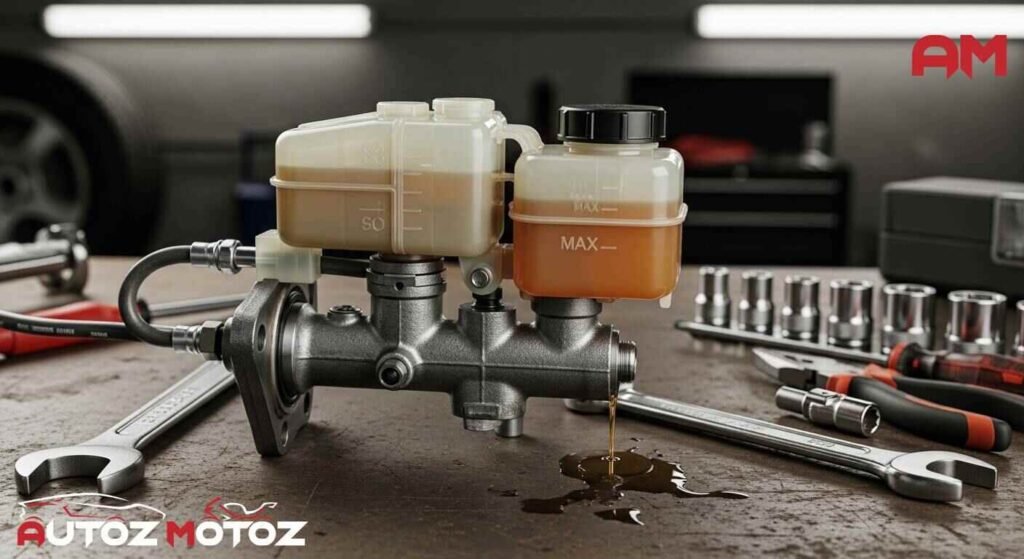Critical hydraulic components form the backbone of modern vehicle safety systems, delivering life-saving stopping power through precise fluid pressure and reliable mechanical operation. These essential mechanisms convert driver pedal force into controlled hydraulic energy that activates braking assemblies with remarkable precision and consistent performance.
Every time drivers press their brake pedals, these sophisticated cylinders spring into action, pushing brake fluid through complex hydraulic networks to engaging mechanisms at each wheel location. The engineering excellence behind these vital components ensures rapid response times, smooth operation, and unwavering reliability under extreme stress conditions and demanding usage scenarios.
Modern automotive safety depends heavily on proper cylinder function, as these components directly influence stopping distances, brake feel, and overall vehicle control during emergency situations. Professional-grade materials and advanced manufacturing techniques ensure long-term durability and consistent performance throughout extended service life.
Understanding these fundamental systems empowers car owners to recognize maintenance needs, identify potential problems, and appreciate the engineering marvels that keep families safe on every journey. Regular inspection and timely replacement of these crucial components remain essential for optimal vehicle safety and reliable operation.
Why Brake Cylinders Are the Hidden Heroes of Car Safety
Most drivers rarely think about what happens behind the brake pedal until something goes wrong. Yet, tucked away in your vehicle’s braking system is a small but powerful component that makes stopping possible—the brake cylinder. Without it, your car wouldn’t respond to sudden stops, emergency maneuvers, or even routine traffic signals.
A brake cylinder is the heart of the hydraulic braking system. When you press the pedal, it converts that simple force into hydraulic pressure, pushing brake fluid through the lines and forcing your brake pads to clamp down. It’s a chain reaction of precision and reliability, designed to keep you safe even at highway speeds.
The hidden role of the brake cylinder becomes more critical in emergency conditions. Imagine a slippery road, a distracted driver ahead, or a child running into the street—without a responsive cylinder, reaction time is lost. That tiny fraction of a second can mean the difference between a close call and a collision.
Key reasons the brake cylinder matters so much:Silent strength: It works constantly without notice, but any failure can be catastrophic.
Direct link to safety: Proper function ensures even brake pressure on all wheels.
Performance factor: A well-maintained cylinder improves stopping distance.
Cost saver: Regular checks prevent expensive repairs caused by fluid leaks or uneven wear.
Drivers often replace tires, upgrade engines, or invest in safety kits, but the brake cylinder rarely gets the spotlight. Recognizing its role not only improves your car’s reliability but also gives you peace of mind knowing that every press of the pedal is backed by precision engineering.
Common Brake Cylinder Problems Drivers Ignore Until It’s Too Late
Brake issues often start silently. Unlike a flat tire or dead battery, a failing brake cylinder doesn’t always announce itself with obvious signs. Many drivers only discover the problem when their car no longer responds as expected—by then, it’s a costly and risky situation.
The brake cylinder is highly vulnerable to wear because it handles continuous hydraulic pressure. Over time, seals wear out, fluid leaks, and rust or debris can compromise performance. Ignoring these early warnings puts both driver and passengers at serious risk.
Warning signs of a failing brake cylinder include:A soft or spongy brake pedal.
Fluid leaks near the wheels or under the hood.
Uneven braking or pulling to one side.
Dashboard brake warning lights.
Longer stopping distance even with firm pedal pressure.
What makes this issue dangerous is that many people mistake these symptoms for “normal wear” or delay inspections due to cost or time. In reality, brake cylinder failure rarely fixes itself—it only gets worse.
Timely maintenance is cheaper and safer than replacing the entire brake system after damage spreads. Professional checks, fluid replacement, and immediate repair when leaks are spotted can extend the life of your cylinder and save you from dangerous roadside breakdowns.The next time you notice an unusual braking response, don’t dismiss it. That hesitation could be your car’s way of signaling that its brake cylinder needs urgent attention—before it turns a simple drive into a life-threatening situation.
How Modern Technology is Reinventing Brake Cylinders for Safer Roads
Car safety has come a long way, and the brake cylinder is no exception. Once a simple hydraulic component, it is now benefiting from advanced materials, precision engineering, and smart design that reduce risks while improving performance.
Unlike older models that were prone to leaks and wear, today’s brake cylinders often feature corrosion-resistant coatings, better seals, and tighter manufacturing tolerances. These improvements mean fewer unexpected failures and longer service life.
Some modern systems even integrate electronic sensors to monitor pressure levels and detect issues before they become critical. This predictive technology alerts drivers early, helping avoid accidents caused by unnoticed leaks or reduced braking force.
Key improvements in new-generation brake cylinders include:Lightweight alloys that resist heat and stress.
Enhanced rubber seals for better hydraulic fluid retention.
Compatibility with eco-friendly brake fluids.
Smarter integration with ABS and stability systems.
While many drivers never think about this small part, it plays a central role in ensuring every stop is precise and reliable. Manufacturers are investing heavily in innovation because even the smallest gains in brake efficiency can save countless lives on the road.
Essential Components of Automotive Brake Cylinders
Critical hydraulic components form the backbone of modern vehicle safety systems, delivering precise fluid pressure that activates braking mechanisms with reliable consistency. Understanding these vital elements helps drivers appreciate brake performance and maintenance requirements.
💪 Master Cylinder Assembly:
The command center that converts pedal force into hydraulic pressure, featuring pistons, seals, and reservoir chambers that regulate fluid flow to wheel cylinders with meticulous precision
🔧 Wheel Cylinder Mechanism:
Dual-piston configurations that amplify hydraulic force to brake shoes or calipers, utilizing high-strength materials and corrosion-resistant coatings for extended durability under extreme temperature conditions
🛡️ Sealing System Elements:
Vital gaskets, O-rings, and dust boots that prevent fluid leakage and contaminant intrusion, ensuring system integrity and optimal performance throughout extended service intervals
🔩 Mounting Hardware:
Precision-engineered brackets, bolts, and alignment components that secure cylinder assemblies while withstanding vibration stress and thermal expansion during demanding braking operations
🎯 Fluid Management Parts:
Check valves, bleeder screws, and compensating ports that control hydraulic flow, remove air bubbles, and maintain proper fluid levels for consistent braking response and enhanced safety performance
These interconnected components work in perfect harmony to deliver life-saving stopping power that modern drivers absolutely depend upon for safe vehicle operation.
Diverse Types of Automotive Brake Cylinders
Modern vehicle braking systems utilize specialized hydraulic components designed for specific applications and performance requirements. Understanding these varied configurations helps car owners make informed maintenance decisions and professional technicians select appropriate replacement parts.
• Single Acting Master Cylinder:
Basic hydraulic control unit that pressurizes fluid in one direction only, commonly found in older vehicle models and simple braking systems requiring fundamental stopping power
• Dual Acting Master Cylinder:
Advanced dual-chamber design that provides redundancy and enhanced safety through separate hydraulic circuits for front and rear brakes, ensuring continued operation even if one circuit fails
• Disc Brake Caliper Cylinder:
Integrated piston assembly within brake calipers that forces brake pads against rotor surfaces with precise hydraulic pressure, delivering superior stopping performance for modern disc brake systems
• Drum Brake Wheel Cylinder:
Dual-piston mechanism that pushes brake shoes outward against drum interiors, providing reliable braking force for rear wheel applications and commercial vehicle systems
• Tandem Master Cylinder:
Multi-stage hydraulic amplifier that controls multiple brake circuits simultaneously, offering enhanced fluid capacity and improved pressure distribution for heavy-duty applications
• Fixed Caliper Cylinder: Multi-piston configuration with stationary mounting that provides superior clamping force and consistent performance for high-performance vehicles and sports car applications
• Móvel Floating Caliper Cylinder:
Single-piston sliding design that moves laterally to center rotor position, offering cost-effective performance and simplified maintenance for standard passenger vehicles
• High-Performance Racing Cylinder:
Specialized competition-grade components with enhanced heat dissipation and maximum pressure capabilities for track racing and extreme performance applications
• Commercial Vehicle Cylinder:
Heavy-duty construction with increased fluid capacity and robust materials designed for trucks, buses, and industrial equipment requiring maximum durability and extended service intervals
• Compact Master Cylinder:
Space-saving design with reduced dimensions and optimized fluid efficiency for smaller vehicles, motorcycles, and compact car applications where space limitations exist
These diverse hydraulic solutions ensure optimal braking performance across various vehicle types and operating conditions, providing drivers with reliable safety systems they can trust completely.
Conclusion
Critical hydraulic components represent the foundation of automotive safety systems, providing essential stopping power that protects drivers and passengers during every journey. These sophisticated mechanisms demonstrate remarkable engineering excellence through precise fluid control and reliable performance under extreme conditions.
Modern vehicles depend heavily on proper cylinder function for optimal braking efficiency, consistent response times, and enhanced safety standards. Regular maintenance, professional inspection, and timely replacement ensure these vital systems continue delivering unwavering reliability and life-saving performance.
Informed car owners who understand component importance make better maintenance decisions, prevent costly failures, and extend vehicle lifespan through proactive care and quality replacement parts. Investing in premium components and professional service provides peace of mind and superior safety for every road trip.
Future automotive innovations promise even greater performance and enhanced reliability through advanced materials and smart technology integration. Staying informed about system developments and maintenance best practices ensures continued safety and optimal vehicle performance for years to come.
Frequently Asked Questions
What are the symptoms of a failing master cylinder and how much does replacement cost?
Drivers frequently search for warning signs that indicate brake cylinder problems before complete failure occurs. Common symptoms include spongy brake pedal feel, brake fluid leaks under the vehicle, pedal sinking to the floor, and illuminated brake warning lights on the dashboard. Early detection prevents dangerous driving conditions and expensive repair bills. Replacement costs typically range from $200-$500 for parts and labor, depending on vehicle make and model. Professional diagnosis is essential since symptoms can mimic other brake system issues. Regular inspection during oil changes helps identify problems early, saving money and ensuring safety.
How do I bleed air from brake cylinders and what tools are required for DIY bleeding?
Car owners actively search for brake bleeding procedures to eliminate spongy pedal feel and restore proper braking performance. The process requires basic tools including a wrench set, clear tubing, brake fluid, and an assistant to operate the pedal. Gravity bleeding, pressure bleeding, and vacuum bleeding are common methods, with gravity bleeding being most accessible for beginners. Proper sequence starts with the wheel farthest from the master cylinder and works toward the closest. Fresh DOT 3 or DOT 4 fluid prevents contamination and ensures optimal performance. Incorrect bleeding can introduce more air or damage seals, making professional service advisable for complex systems.
What causes brake wheel cylinders to leak and can I drive with a leaking cylinder?
Safety-conscious drivers want to understand brake cylinder leak causes and driving risks. Common causes include worn seals, corrosion from moisture exposure, physical damage from road debris, and age-related component deterioration. Internal rubber seals harden and crack over time, allowing brake fluid to escape. Driving with leaks is extremely dangerous as it reduces braking power and can lead to complete brake failure. Immediate repair is mandatory – even small leaks worsen over time. Temporary fixes like electrical tape are unsafe and illegal. Professional replacement ensures proper function and legal compliance for vehicle operation.
How often should brake cylinders be replaced and what is their lifespan?
Vehicle maintenance planners seek guidance on brake cylinder service intervals and longevity factors. Master cylinders typically last 75,000-100,000 miles with proper care, while wheel cylinders may need replacement every 50,000-75,000 miles depending on usage and environmental conditions. Regular brake fluid changes every 2-3 years prevent internal corrosion and seal degradation. Quality brake fluid with proper moisture absorption characteristics extends component life. Avoiding aggressive braking and maintaining consistent driving habits reduce wear. Professional inspection during annual services identifies potential issues before failure occurs, maximizing safety and minimizing unexpected repair costs.
Can I replace just one brake cylinder or do I need to replace them in pairs?
Cost-conscious car owners want to minimize repair expenses while maintaining safety standards. Generally, replacing brake cylinders in pairs ensures balanced braking performance and prevents pulling during stops. However, single cylinder replacement is acceptable if the opposite side shows no signs of wear or leakage. Factors affecting this decision include vehicle age, mileage, driving conditions, and budget constraints. Professional assessment determines whether companion components need replacement. Mixing old and new cylinders can create uneven braking force distribution. Quality aftermarket parts from reputable manufacturers provide reliable alternatives to expensive OEM components while maintaining safety standards.
Tech innovator and business strategist with a foundation in Computer Science and diverse expertise in IT, marketing, and banking. Committed to building disruptive products and customer experiences that shape industries and create global market dominance.









One Response